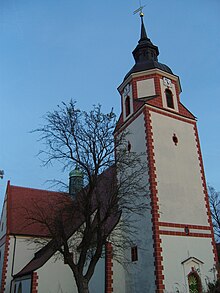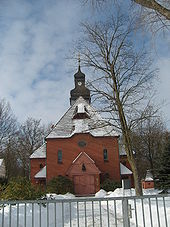Klettwitz
|
Klettwitz
community Schipkau
Coordinates: 51 ° 32 ′ 34 " N , 13 ° 53 ′ 42" E
|
|
|---|---|
| Height : | 120 m above sea level NHN |
| Area : | 17.58 km² |
| Residents : | 1300 (December 31, 2016) |
| Population density : | 74 inhabitants / km² |
| Incorporation : | December 31, 2001 |
| Postal code : | 01998 |
| Area code : | 035754 |
Klettwitz ( Sorbian : Klěśišća ) is a place in the Oberspreewald-Lausitz district in southern Brandenburg and part of the municipality of Schipkau . It is located west of the city of Senftenberg in Niederlausitz . Klettwitz was partially devastated in the course of lignite mining .
history
Finds indicate a settlement as early as the Bronze Age .
In 1370 Klettwitz was first mentioned as "Cleticz". The place name probably goes back to the Sorbian word "skład" and means "place where there are pantries". Klettwitz belonged to the Saxon Senftenberg Office, and residents were forced to eat at the Office's official mill in Senftenberg. In the course of the Reformation , Klettwitz became an independent Protestant parish in 1540 . The neighboring communities of Särchen belong to the parish - today Annahütte , Meuro , Drochow , Kostebrau and at times also Saalhausen .
The Royal Upper Mining Authority in Halle approved the operation of the Felix lignite mine in 1867 . Further coal mines were added in the following years. In the 1890s the Felix , Wilhelminensglück and Klettwitzer Montanwerke briquette factories were established . In the course of industrialization , settlements such as Wilhelminensglück and an almost urban infrastructure emerged. In 1899, the Knappschaftsverein laid the foundation stone for the construction of the Klettwitz miners' hospital, which is now part of the Niederlausitz Clinic. In the same year Franz Skarbina created his oil painting "Braunkohlenwerk (Clettwitz)". This older spelling was in use until the 20th century.
The Klettwitz opencast mine was opened up in 1949 . The open pit worked until 1991, almost 5200 hectares of land was dredged over and 362 million tons of lignite mined. Part of the local area of Klettwitz was devastated from 1963/1964. 1200 inhabitants were resettled, 200 of them within the village.
At the beginning of the 1960s there was a forced collectivization of the individual farms and the LPG "Pößnitztal" was formed. This worked until 1987.
In 1984 the council of the district of Cottbus decided . to dredge the place Klettwitz completely by the new opencast mine Klettwitz-Nord by 2004. As a result, the place fell into disrepair combined with a decline in population. After the political change in 1989, the plans for the final devastation of the place were lifted. The Klettwitz-Nord opencast mine was operated from 1988 to 1992. The remaining hole is currently being converted into Bergheider See , which was flooded in May 2014. The former overburden conveyor bridge F60 , which is accessible as a visitor mine , has been located here since 2002 .
Part of the Barranmühle residential park , which was created in collaboration with the neighboring town of Meuro, is now part of the Klettwitz district .
On December 31, 2001, Klettwitz merged with the towns of Annahütte, Meuro, Schipkau , Drochow and Hörlitz to form the municipality of Schipkau.
Population development
The Staudemühle , Treuhandsiedlung and Wilhelminensglück residential areas belong to Klettwitz .
| Population development in Klettwitz from 1875 to 2000 | |||||||||||
|---|---|---|---|---|---|---|---|---|---|---|---|
| year | Residents | year | Residents | year | Residents | year | Residents | year | Residents | year | Residents |
| 1875 | 709 | 1890 | 1224 | 1910 | 3544 | 1925 | 3163 | 1933 | 3220 | 1939 | 3269 |
| 1946 | 3441 | 1950 | 3520 | 1964 | 2718 | 1971 | 1769 | 1981 | 1377 | 1985 | 1348 |
| 1989 | 1205 | 1990 | 1185 | 1991 | 1117 | 1992 | 1063 | 1993 | 1042 | 1994 | 1176 |
| 1995 | 1252 | 1996 | 1282 | 1997 | 1332 | 1998 | 1368 | 1999 | 1338 | 2000 | 1342 |
Attractions
The oldest building is the vestibule of today's evangelical church , which already existed at the time the place was first mentioned, as indicated by foundations found in the vicinity of the church. At the time of the Reformation, the church was built as a single-nave building with a bell tower, the nave still exists today. In 1774 the church was redesigned in Baroque style . The tower was expanded to its current height of 40 meters. In front of the church there is a memorial to those who died in the First World War. A memorial to those who died in the Franco-Prussian War is located on the village square.
The Catholic Herz-Jesu-Kirche is located in the village of Wilhelminensglück . Both churches are among the architectural monuments in the community of Schipkau .
Since 2001 there has been a reconstructed drainage shaft from mining times that can be viewed.
The " Lausitzring " race track has been in the immediate vicinity since August 20, 2000 . Construction began on this in June 1998. Before that, the Sonnenhäusel motocross track was at this location.
In the cemetery there is a memorial stone from 1966 for 53 Polish , Soviet and Italian slave laborers who perished while working in armaments companies in the town and the surrounding area. There is also a memorial stone in the cemetery for the Italian slave laborers, which the Republic of Italy had erected.
Infrastructure
economy
The LAUSITZ Family Campus is located in Klettwitz. This is a 100% subsidiary of Klinikum Niederlausitz GmbH.
The Klettwitz wind farm was built in the Klettwitz suburb from 1998 to November 1999. In the Klettwitz-Nord wind farm , 38 wind turbines generate electricity for over 30,000 households.
The DEKRA Technology Center and parts of the Niederlausitz Clinic, which runs a nursing school here, are located in Klettwitz .
traffic
South of Klettwitz, the L 551 road leads to the Klettwitz junction of the A 13 Berlin – Dresden motorway , which runs east of the town. Because of the open pit, the road to Kostebrau had to be relocated.
Passenger traffic on the Finsterwalde – Schipkau railway with the stations Klettwitz and Klettwitz Hospital was discontinued in 1966.
Personalities
- Gottlob Schumann (1860–1929), General Director of Ilse Bergbau, was born in Klettwitz.
- Robert Harnau (1908–1977), politician (SPD / SED) and resistance fighter against National Socialism, was born in Klettwitz.
- Gerd König (1930–2009), politician (SED) and diplomat, was born in Klettwitz.
- Herbert Richter (1933–2018), chemist, was born in Klettwitz.
- Heinz Klevenow (* 1940), actor and theater director, lives in Klettwitz.
- Fritz Stavenhagen (* 1945), actor, was born in Klettwitz.
- Ilona Nicklisch (* 1958), politician (BVB / Free Voters), was born in Klettwitz.
Individual evidence
- ↑ Community and district directory of the state of Brandenburg. Land surveying and geographic base information Brandenburg (LGB), accessed on June 17, 2020.
- ↑ Reinhard E. Fischer : The place names of the states of Brandenburg and Berlin: age - origin - meaning . be.bra Wissenschaft, 2005, p. 91 .
- ↑ Information board at the location of the former official mill in Senftenberg
- ↑ Brandenburg Lusatia flooding level. In: lmbv.de. Lausitzer und Mitteldeutsche Bergbau-Verwaltungsgesellschaft mbH, December 2017, accessed on May 3, 2018 .
- ↑ Area changes from 01.01. until December 31, 2001. In: destatis.de. Federal Statistical Office, July 1, 2007, accessed on May 3, 2018 .
- ^ Contribution to the statistics: Historical municipality register of the state of Brandenburg 1875 to 2005. (PDF; 331 kB) In: statistik-berlin-brandenburg.de. State Office for Data Processing and Statistics Brandenburg, December 2006, accessed on May 3, 2018 .
- ↑ Calendar of Sparkasse Niederlausitz 2008
literature
- Frank Förster : Disappeared Villages - The demolitions of the Lusatian lignite mining area until 1993. Domowina-Verlag, Bautzen 1995.
Web links
- List of excavated villages in Lusatia
- Klettwitz on the website of the community Schipkau
- Statistics of the Lusatian Sorbs: The municipality of Klettwitz. ( Arnošt Muka , 1884–86)



